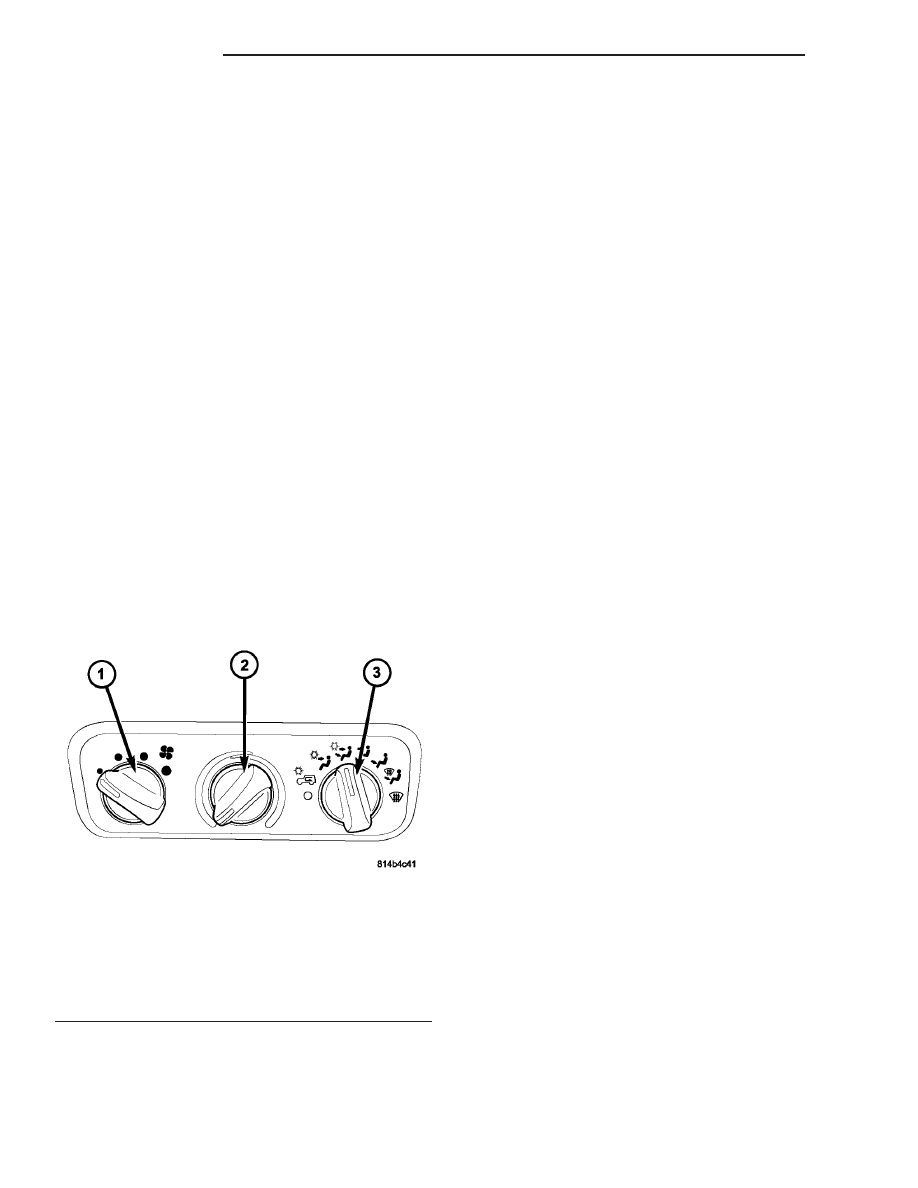Jeep Wrangler TJ. Manual - part 591

INSTALLATION
(1) From under the instrument panel, position the
blower motor resistor into the HVAC housing.
(2) From under the instrument panel, install the
lower screw that secures the blower motor resistor to
the HVAC housing. Tighten the screw to 2 N·m (17
in. lbs.).
(3) Reach through the glove box opening and
install the upper screw that secures the blower motor
resistor to the HVAC housing. Tighten the screw to 2
N·m (17 in. lbs.).
(4) Connect the wire harness connector to the
blower motor resistor and engage the connector lock.
(5) Install the glove box (Refer to 23 - BODY/IN-
STRUMENT PANEL/GLOVE BOX - INSTALLA-
TION).
(6) Reconnect the negative battery cable.
BLOWER MOTOR SWITCH
DESCRIPTION
The blower motor for the heater-only or heater-A/C
system is controlled by a rotary-type blower motor
switch, mounted in the A/C-heater control (Fig. 28).
The blower motor switch allows the selection of four
different blower motor speeds and includes an Off
position.
OPERATION
The blower motor switch provides a ground path
for the blower motor through the A/C-heater mode
control. The blower motor switch directs this ground
path through or around the blower motor resistor
wires, as required to achieve the selected blower
motor speed.
The blower motor switch cannot be repaired and, if
faulty or damaged, it must be replaced. The blower
motor switch knob is available for service replace-
ment.
DIAGNOSIS AND TESTING
BLOWER MOTOR SWITCH
WARNING: On vehicles equipped with airbags, dis-
able the airbag system before attempting any steer-
ing wheel, steering column, or instrument panel
component diagnosis or service. Disconnect and
isolate the battery negative (ground) cable, then
wait two minutes for the airbag system capacitor to
discharge before performing further diagnosis or
service. This is the only sure way to disable the air-
bag system. Failure to take the proper precautions
could result in accidental airbag deployment and
possible personal injury or death.
For circuit descriptions and diagrams, refer to the
appropriate wiring information. The wiring informa-
tion includes wiring diagrams, proper wire and con-
nector repair procedures, further details on wire
harness routing and retention, as well as pin-out and
location views for the various wire harness connec-
tors, splices and grounds.
(1) Check for battery voltage at the fuse in the
power distribution center (PDC). If OK, go to Step 2.
If not OK, repair the shorted circuit or component as
required and replace the faulty fuse.
(2) Turn the ignition switch to the Off position.
Disconnect and isolate the negative battery cable.
Remove the A/C-heater control from the instrument
panel (Refer to 24 - HEATING & AIR CONDITION-
ING/CONTROLS/A/C
HEATER
CONTROL
-
REMOVAL).
Check
for
continuity
between
the
ground circuit cavity of the A/C-heater control wire
harness connector and a good ground. There should
be continuity. If OK, go to Step 3. If not OK, repair
the open circuit to ground as required.
(3) With the A/C-heater control wire harness con-
nector disconnected, place the A/C-heater mode con-
trol in any position except Off. Check for continuity
between the ground circuit terminal and each of the
blower motor driver circuit terminals of the A/C-
heater control as you move the blower motor switch
to each of the four speed positions. There should be
continuity at each driver circuit terminal in only one
blower motor switch speed position. If OK, test and
repair the blower driver circuits between the A/C-
heater control and the blower motor resistor as
required. If not OK, replace the faulty blower motor
switch.
Fig. 28 A/C-Heater Control - Typical
1 - BLOWER SPEED CONTROL
2 - TEMPERATURE SELECT COPNTROL
3 - MODE SELECT CONTROL
24 - 30
CONTROLS
TJ
BLOWER MOTOR RESISTOR (Continued)